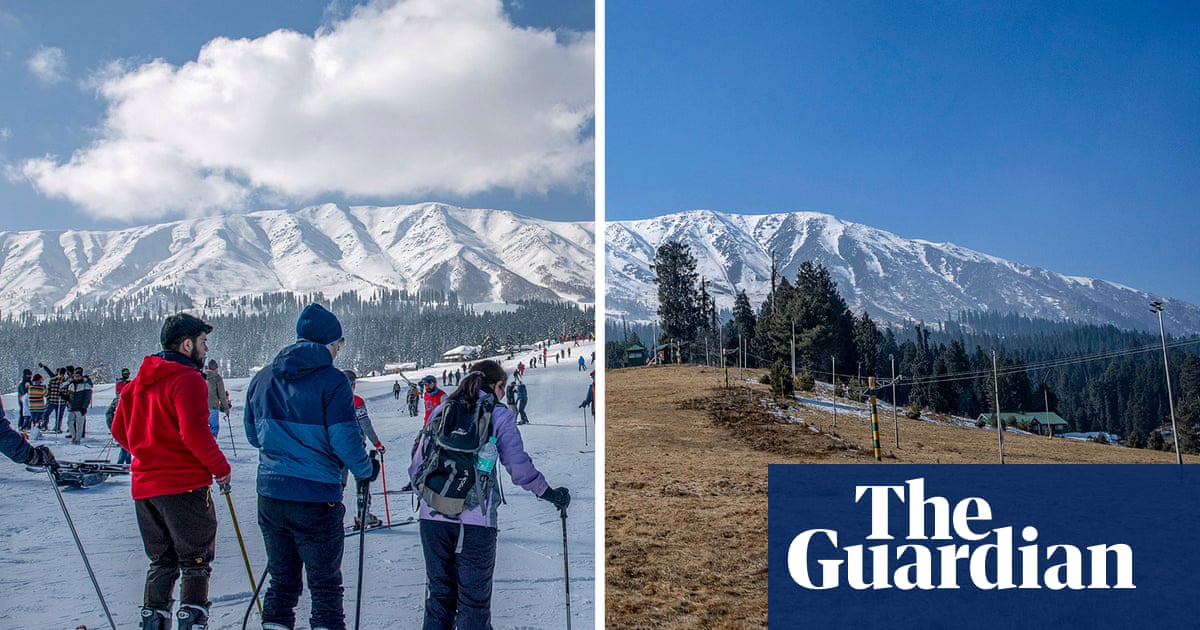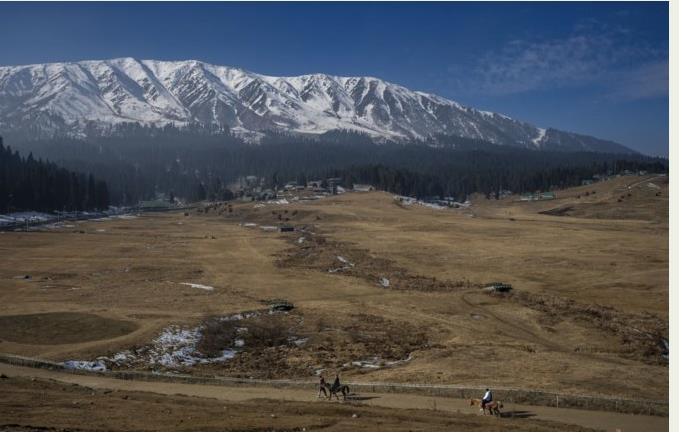
As evening draws near, Bashir Ahmad Bhat is still waiting for his first customer of the day. Seven years ago, Bhat, 34, gave up his job as a driver to work in Gulmarg’s tourism sector. January is peak season at India’s premier ski resort, attracting amateur and professional skiers from around the world.
The father of two usually earns good money during the four months when Gulmarg, in the Indian-administered Jammu and Kashmir region, is covered in a thick layer of fine powder snow.
This season, however, has been a disaster. No snow has fallen so far in January and there was just one day of snow in December. “It has been a complete loss,” says Bhat. “We have never seen such a situation in our lifetime. I have not even earned enough money so far to pay my rent.”
Gulmarg, which means “meadow of flowers”, is a picturesque town on the western edge of the Kashmir valley. Thousands of people work in the tourism industry, which accounts for 7% of Jammu and Kashmir’s annual GDP, which was 2,279bn rupees (£21.5bn) in 2022-23. More than 2.25 million visitors were predicted to visit Jammu and Kashmir last year, according to the lieutenant-governor of the territory, though the figure includes pilgrims as well as tourists.
“We have been badly hit,” says Rauf Tramboo, president of the Travel Agents Association of Kashmir, adding that about 75% of bookings had been cancelled. He says it is too early to assess losses, “but it is a lot of money”.
“The delay in snowfall has created a lot of problems for everyone, but particularly those associated with winter tourism and adventure tourism,” Tramboo says.
“For the last few years, Gulmarg saw a surge in winter sports tourism and for three to four months – December to March – it would be jam-packed.
This season we have not been able to do any activity, not a single day of work
Farhat Naik, snowboarding instructor
The boom had spurred local operators to invest in adventure tourism equipment, he says, adding: “Some of them raised their investments by taking loans from financial institutions or by selling their assets.”
Farhat Naik, 30, a snowboarding instructor, says all his clients – mainly from Europe and the US – have either cancelled or postponed their trips this year.
“It is heartbreaking, very disappointing,” he says. “Gulmarg is usually white in winter, but this time it is not. This season we have not been able to do any activity, not a single day of work.”
Naik says changing weather patterns in recent years had already reduced the number of days he could earn money.
“My work is dependent on winter and snow, and I have never seen such a scenario,” he says, adding that he has lost “a good amount of money that would have sustained me for the rest of the year. Earlier, we would work for 90 days; now we rely on 60 or 70 days.”
It is not just the tourism sector feeling the affect of no snow. A senior official in the Kashmir administration warned last week that the lack of snow could disrupt the region’s water supply, which could prove catastrophic.
The winter snow provides drinking water, irrigates paddy fields and powers 19 vital hydropower projects. Officials have already been forced to reduce household electricity supply to a maximum of 16 hours a day due to the “all-time low” water supply to its hydroelectric turbines.
Sanjeev Malhotra, a chief engineer in Jal Shakti, the ministry of water resources, says: “We won’t say it is an alarming situation for now, but it is bordering on an alarming situation. If the dry spell continues, then naturally we will face difficulty [in the summer months]. The people must use water judiciously.”
Irfan Rashid, an assistant professor of geoinformatics at the University of Kashmir, has for years warned of the severe impact of the warming climate on the sustainability of winter tourism in Kashmir, and on hydropower generation and agriculture “if weather conditions do not improve”.
“The snow [during the] 40-day severest part of winter, between 21 December and 29 January, is important for regulating glacier health and stream flows,” he says.
Seventeen kilometres downhill from Gulmarg, in Kalantra village, Bilal Ahmad Bhat sits on the 1.3m-rupee (£12,300) all-terrain vehicle he invested in to transport skiers.
“For the past month, I have had no work. There are no tourists here and those who come, they leave quickly,” he says. He says that this time last year, there was at least 60cm (2ft) of snow in Gulmarg and 1.5-3 metres of snow on the mountain slopes. “I don’t know how I will pay the [loan for the vehicle] to the bank,” he says.
Aijaz Ahmad Dar, a resident of Kashmir’s largest city, Srinagar, who manages holiday accommodation, says he is receiving almost daily cancellations. “If there would have been snowfall, all our huts would have been booked. But we had almost 80% cancellations,” he says. “This is the worst-case scenario.”
However, Billa Majeed Bakshi, who operates Kashmir Heli Ski, which flies professional – mainly foreign – skiers to high-altitude slopes, remains optimistic. “This is still the beginning of the winter,” he says. We still have two more months, we can even ski till the end of April because at high altitudes snow will be good and powdery.
“This is nature and we cannot fight nature,” he adds. “We cannot lose hope and courage.”












